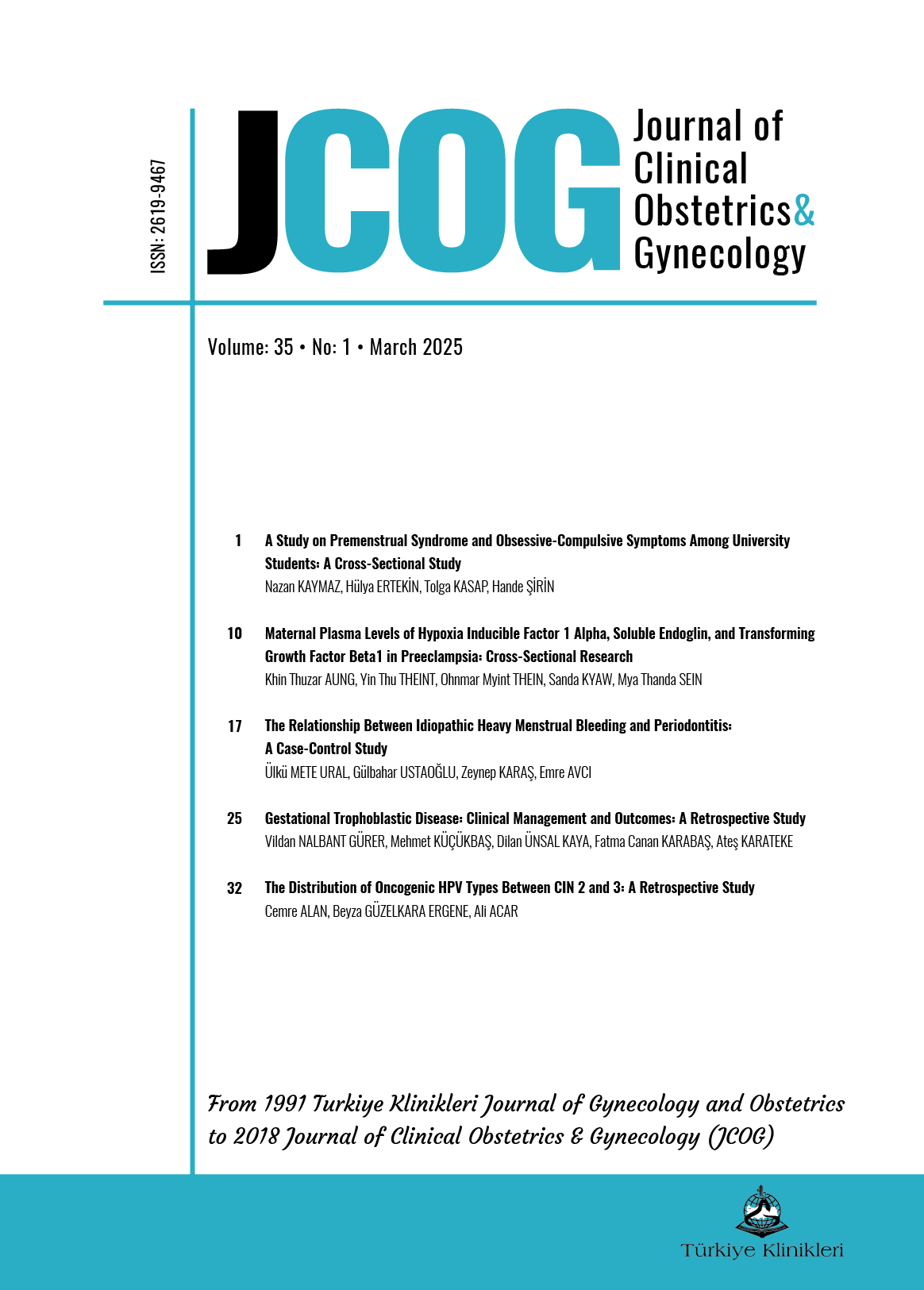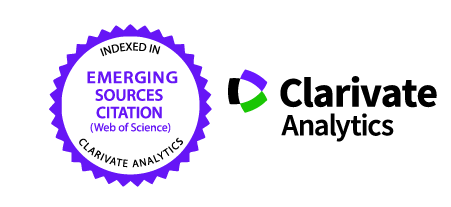Open Access
Peer Reviewed
ORIGINAL RESEARCH
919 Viewed951 Downloaded
A Study on Premenstrual Syndrome and Obsessive-Compulsive Symptoms Among University Students: A Cross-Sectional Study
Received: 08 Oct 2024 | Accepted: 04 Feb 2025 | Available online: 21 Feb 2025
JCOG. 2025;35(1):1-9
DOI: 10.5336/jcog.2024-106101
Article Language: EN
Article Language: EN
Copyright Ⓒ 2025 by Türkiye Klinikleri. This is an open access article under the CC BY-NC-ND license (http://creativecommons.org/licenses/by-nc-nd/4.0/)
ABSTRACT
Objective: The present study aimed to investigate the potential correlation between Premenstrual syndrome (PMS) and obsessive-compulsive symptoms (OCS) among university students. Material and Methods: A cross-sectional study was conducted with female students from Çanakkale Onsekiz Mart University, excluding those with neuropsychiatric or chronic physical illnesses. The data included sociodemographics (age, height, weight, economic status, menstrual cycle characteristics) and health behaviors (smoking, alcohol consumption). Premenstrual symptoms were evaluated with the PMS Scale (PMSS) and OCS with the Maudsley Obsessional-Compulsive Inventory (MOCIT). Participants were grouped based on PMSS scores indicating PMS presence, and correlation and regression analyses explored the relationship between PMS and OCS. Results: A total of 552 females aged 18-24 (mean age: 20.22±1.56) participated, with 74.2% (n=410) reporting PMS. PMS individuals had markedly higher total MOCI-T scores than non-PMS individuals (p≤0.001). PMSS dimensions (except for abdominal bloating and appetite changes) showed associations with MOCI-T, with rumination exhibiting the strongest positive correlations (p≤0.001). MOCI-T scores also correlated significantly with anxiety and depressive thoughts, with anxiety having a slightly stronger impact (B=0.315, β=0.318, p≤0.001 vs B=0.174, β=0.194, p≤0.001). Conclusion: The results indicate a significant link between PMS and OCS, emphasizing the intertwining of menstrual health and mental well-being in young females. Moreover, the correlations between PMS dimensions, OCS, and psychological factors like anxiety and depressive thoughts suggest a multifaceted relationship deserving a further study.
Objective: The present study aimed to investigate the potential correlation between Premenstrual syndrome (PMS) and obsessive-compulsive symptoms (OCS) among university students. Material and Methods: A cross-sectional study was conducted with female students from Çanakkale Onsekiz Mart University, excluding those with neuropsychiatric or chronic physical illnesses. The data included sociodemographics (age, height, weight, economic status, menstrual cycle characteristics) and health behaviors (smoking, alcohol consumption). Premenstrual symptoms were evaluated with the PMS Scale (PMSS) and OCS with the Maudsley Obsessional-Compulsive Inventory (MOCIT). Participants were grouped based on PMSS scores indicating PMS presence, and correlation and regression analyses explored the relationship between PMS and OCS. Results: A total of 552 females aged 18-24 (mean age: 20.22±1.56) participated, with 74.2% (n=410) reporting PMS. PMS individuals had markedly higher total MOCI-T scores than non-PMS individuals (p≤0.001). PMSS dimensions (except for abdominal bloating and appetite changes) showed associations with MOCI-T, with rumination exhibiting the strongest positive correlations (p≤0.001). MOCI-T scores also correlated significantly with anxiety and depressive thoughts, with anxiety having a slightly stronger impact (B=0.315, β=0.318, p≤0.001 vs B=0.174, β=0.194, p≤0.001). Conclusion: The results indicate a significant link between PMS and OCS, emphasizing the intertwining of menstrual health and mental well-being in young females. Moreover, the correlations between PMS dimensions, OCS, and psychological factors like anxiety and depressive thoughts suggest a multifaceted relationship deserving a further study.
REFERENCES:
- ACOG Committee on Practice Bulletins--Gynecology. ACOG Practice Bulletin: No 15: Premenstrual syndrome. Obstet Gynecol. 2000;95(4):suppl 1-9. Retraction in: Obstet Gynecol. 2012;120(2 Pt 1):405. [PubMed]
- Halbreich U, Kahn LS. Selective oestrogen receptor modulators--current and future brain and behaviour applications. Expert Opin Pharmacother. 2000;1(7):1385-98. [Crossref] [PubMed]
- Sacher J, Zsido RG, Barth C, Zientek F, Rullmann M, Luthardt J, et al. Increase in serotonin transporter binding in patients with premenstrual dysphoric disorder across the menstrual cycle: a case-control longitudinal neuroreceptor ligand positron emission tomography ımaging study. Biol Psychiatry. 2023;93(12):1081-8. [Crossref] [PubMed]
- Nappi RE, Cucinella L, Bosoni D, Righi A, Battista F, Molinaro P, et al. Premenstrual syndrome and premenstrual dysphoric disorder as centrally based disorders. Endocrines. 2022;3(1):127-38. [Crossref]
- Acikgoz A, Dayi A, Binbay T. Prevalence of premenstrual syndrome and its relationship to depressive symptoms in first-year university students. Saudi Med J. 2017;38(11):1125-31. [Crossref] [PubMed] [PMC]
- Yonkers KA. Anxiety symptoms and anxiety disorders: how are they related to premenstrual disorders? J Clin Psychiatry. 1997;58 Suppl 3:62-7; discussion 68-9. [PubMed]
- Prasad D, Wollenhaupt-Aguiar B, Kidd KN, de Azevedo Cardoso T, Frey BN. Suicidal risk in women with premenstrual syndrome and premenstrual dysphoric disorder: a systematic review and meta-analysis. J Womens Health (Larchmt). 2021;30(12):1693-707. [Crossref] [PubMed] [PMC]
- Vulink NC, Denys D, Bus L, Westenberg HG. Female hormones affect symptom severity in obsessive-compulsive disorder. Int Clin Psychopharmacol. 2006;21(3):171-5. [Crossref] [PubMed]
- Ruscio AM, Stein DJ, Chiu WT, Kessler RC. The epidemiology of obsessive-compulsive disorder in the National Comorbidity Survey Replication. Mol Psychiatry. 2010;15(1):53-63. [Crossref] [PubMed] [PMC]
- Labad J, Menchón JM, Alonso P, Segalàs C, Jiménez S, Vallejo J. Female reproductive cycle and obsessive-compulsive disorder. J Clin Psychiatry. 2005;66(4):428-35; quiz 546. [Crossref] [PubMed]
- Gençdoğan B. Premenstruel sendrom için yeni bir ölçek. Türkiye'de Psikiyatri Derg. 2006;8(2):81-7. [Link]
- Hodgson RJ, Rachman S. Obsessional-compulsive complaints. Behav Res Ther. 1977;15(5):389-95. [Crossref] [PubMed]
- Erol N, Savaşır I. Maudsley Obsesif Kompulsif Soru Listesi. XXIV. Ulusal Psikiyatri ve Nörolojik Bilimler Kongresi Bildiri Kitabı. Ankara: GATA Basımevi; 1988. 107-14.
- Bertone-Johnson ER, Whitcomb BW, Rich-Edwards JW, Hankinson SE, Manson JE. Premenstrual syndrome and subsequent risk of hypertension in a prospective study. Am J Epidemiol. 2015;182(12):1000-9. [PubMed] [PMC]
- Halbreich U, Borenstein J, Pearlstein T, Kahn LS. The prevalence, impairment, impact, and burden of premenstrual dysphoric disorder (PMS/PMDD). Psychoneuroendocrinology. 2003;28 Suppl 3:1-23. [Crossref] [PubMed]
- Bhuvaneswari K, Rabindran P, Bharadwaj B. Prevalence of premenstrual syndrome and its impact on quality of life among selected college students in Puducherry. Natl Med J India. 2019;32(1):17-9. [Crossref] [PubMed]
- Halbreich U, Kahn LS. Role of estrogen in the aetiology and treatment of mood disorders. CNS Drugs. 2001;15(10):797-817. [Crossref] [PubMed]
- Hartlage SA, Brandenburg DL, Kravitz HM. Premenstrual exacerbation of depressive disorders in a community-based sample in the United States. Psychosom Med. 2004;66(5):698-706. [Crossref] [PubMed]
- Fernández MDM, Saulyte J, Inskip HM, Takkouche B. Premenstrual syndrome and alcohol consumption: a systematic review and meta-analysis. BMJ Open. 2018;8(3):e019490. [Crossref] [PubMed] [PMC]
- Bertone-Johnson ER, Hankinson SE, Johnson SR, Manson JE. Timing of alcohol use and the incidence of premenstrual syndrome and probable premenstrual dysphoric disorder. J Womens Health (Larchmt). 2009;18(12):1945-53. [Crossref] [PubMed] [PMC]
- Du?ková M, Simůnková K, Hill M, Velíková M, Kubátová J, Kancheva L, et al. Chronic cigarette smoking alters circulating sex hormones and neuroactive steroids in premenopausal women. Physiol Res. 2012;61(1):97-111. [Crossref] [PubMed]
- Mitsuhashi R, Sawai A, Kiyohara K, Shiraki H, Nakata Y. Factors associated with the prevalence and severity of menstrual-related symptoms: a systematic review and meta-analysis. Int J Environ Res Public Health. 2022;20(1):569. [Crossref] [PubMed] [PMC]
- Tiwari RK, Sharma V, Pandey RK, Shukla SS. Nicotine addiction: neurobiology and mechanism. J Pharmacopuncture. 2020;23(1):1-7. [Crossref] [PubMed] [PMC]
- Endicott J, Amsterdam J, Eriksson E, Frank E, Freeman E, Hirschfeld R, et al. Is premenstrual dysphoric disorder a distinct clinical entity? J Womens Health Gend Based Med. 1999;8(5):663-79. [Crossref] [PubMed]
- Limosin F, Ades J. Aspects psychiatriques et psychologiques du syndrome prémenstruel [Psychiatric and psychological aspects of premenstrual syndrome]. Encephale. 2001;27(6):501-8. French. [PubMed]
- Forray A, Focseneanu M, Pittman B, McDougle CJ, Epperson CN. Onset and exacerbation of obsessive-compulsive disorder in pregnancy and the postpartum period. J Clin Psychiatry. 2010;71(8):1061-8. [Crossref] [PubMed] [PMC]
MENU
POPULAR ARTICLES
MOST DOWNLOADED ARTICLES





This journal is licensed under a Creative Commons Attribution-NonCommercial-NoDerivatives 4.0 International License.










